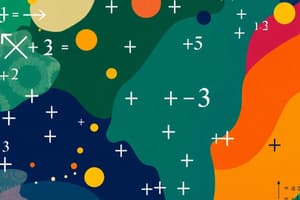Podcast
Questions and Answers
What does the order of operations PEMDAS stand for?
What does the order of operations PEMDAS stand for?
- Parentheses, Exponents, Multiplication, Division, Addition, Subtraction (correct)
- Parentheses, Exponents, Minus, Division, Addition, Subtraction
- Perpendicular, Ends, Multiplication, Division, Addition, Subtraction
- Parentheses, Exponents, Multiplication, Division, Addition, Summation
How is a linear equation typically solved?
How is a linear equation typically solved?
- By expanding the expression
- By applying the Pythagorean theorem
- By using the quadratic formula
- By isolating the variable (correct)
Which theorem helps in finding the relationship between the sides of a right triangle?
Which theorem helps in finding the relationship between the sides of a right triangle?
- Fundamental theorem of arithmetic
- Triangle inequality theorem
- Pythagorean theorem (correct)
- Euclidean theorem
What is the derivative in calculus used to determine?
What is the derivative in calculus used to determine?
In statistics, what does the mode represent?
In statistics, what does the mode represent?
Which operation is NOT a part of vector operations in linear algebra?
Which operation is NOT a part of vector operations in linear algebra?
What does mathematical modeling involve?
What does mathematical modeling involve?
What is the first step in the problem-solving strategy?
What is the first step in the problem-solving strategy?
Flashcards are hidden until you start studying
Study Notes
Basic Concepts
-
Arithmetic
- Operations: addition, subtraction, multiplication, division
- Order of operations: PEMDAS (Parentheses, Exponents, Multiplication and Division, Addition and Subtraction)
-
Algebra
- Variables and constants
- Expressions and equations
- Solving linear equations: isolate the variable
- Quadratic equations: ax² + bx + c = 0, use factoring or the quadratic formula
-
Geometry
- Shapes: triangles, squares, circles, etc.
- Properties: area, perimeter, volume
- Theorems: Pythagorean theorem for right triangles
-
Trigonometry
- Basics: sine, cosine, tangent
- Right triangle relationships
- Unit circle: relationships between angles and coordinates
-
Statistics
- Mean, median, mode, and range
- Standard deviation and variance
- Probability: basic concepts and simple events
Advanced Topics
-
Calculus
- Limits: approach of a function as it nears a certain point
- Derivatives: rate of change, slope of the tangent line
- Integrals: area under a curve, accumulation of quantities
-
Linear Algebra
- Vectors and matrices
- Operations: addition, scalar multiplication
- Determinants and inverses of matrices
-
Discrete Mathematics
- Logic: propositions, truth tables
- Set theory: unions, intersections, Venn diagrams
- Graph theory: vertices, edges, paths, cycles
Mathematical Techniques
-
Problem Solving Strategies
- Understand the problem: clarify and outline
- Develop a plan: choose a strategy, such as working backward or drawing a diagram
- Carry out the plan: implement the chosen strategy
- Review/extend: check the solution's validity and explore further implications
-
Mathematical Proofs
- Types: direct proof, contradiction, contrapositive
- Structure: assumptions, logical deductions, conclusions
Applications of Mathematics
-
Real-life Applications
- Finance: interest rates, budgeting, investments
- Engineering: design, problem-solving, efficiency
- Data analysis: statistics, predictive models
-
Mathematical Modeling
- Creating representations of real-world situations
- Using equations to predict outcomes based on variables
Study Tips
- Practice regularly: consistency helps retention and understanding.
- Break down complex problems into smaller, manageable parts.
- Use visual aids: graphs and diagrams can clarify concepts.
- Engage in group study: discussing with peers enhances learning.
Basic Concepts
-
Arithmetic involves operations like addition, subtraction, multiplication, and division. The order of these operations is determined by the acronym PEMDAS: Parentheses, Exponents, Multiplication and Division (from left to right), and Addition and Subtraction (from left to right).
-
Algebra introduces variables and uses them to represent unknown values. It focuses on understanding and solving equations, which are mathematical statements that express equality between two expressions.
-
Geometry studies the properties of shapes, such as triangles, squares, and circles. It includes concepts such as area, perimeter, and volume, which help us understand the size and shape of geometric figures.
-
Trigonometry deals with the relationships between angles and sides of triangles, especially right triangles. It utilizes sine, cosine, and tangent functions to analyze these relationships.
-
Statistics involves collecting, organizing, analyzing, and interpreting data. Key concepts include measures of central tendency (mean, median, mode), measures of variability (standard deviation, variance), and basic probability concepts.
Advanced Topics
-
Calculus is a branch of mathematics concerned with continuous change and involves concepts like limits, derivatives, and integrals. Derivatives represent the instantaneous rate of change of a function, while integrals measure the accumulation of quantities over a given interval.
-
Linear Algebra studies vectors and matrices, which are mathematical objects that represent quantities with direction and magnitude. It encompasses operations like addition, scalar multiplication, and the calculation of determinants and inverses.
-
Discrete Mathematics explores mathematical structures and their properties. It encompasses logic, set theory, and graph theory. Logic deals with propositions and their truth values, while set theory analyzes sets, their elements, and operations.
Mathematical Techniques
-
Problem Solving Strategies involves understanding the problem, devising a plan, carrying out the plan, and reviewing the solution. Understanding the problem involves clarifying the given information and outlining what needs to be solved.
-
Mathematical Proofs serve to establish the validity of mathematical statements. There are various methods like direct proof, proof by contradiction, and proof by contrapositive.
Applications of Mathematics
- Real-life Applications of mathematics are widespread, including finance, engineering, and data analysis.
- Mathematical Modeling involves creating representations of real-world scenarios using mathematical equations. These models are used to predict outcomes based on predefined variables.
Study Tips
- Practice regularly to enhance retention and understanding.
- Break down complex problems into smaller, manageable parts.
- Use visual aids like graphs and diagrams for better clarification.
- Engage in group study to discuss and learn from peers.
Studying That Suits You
Use AI to generate personalized quizzes and flashcards to suit your learning preferences.





